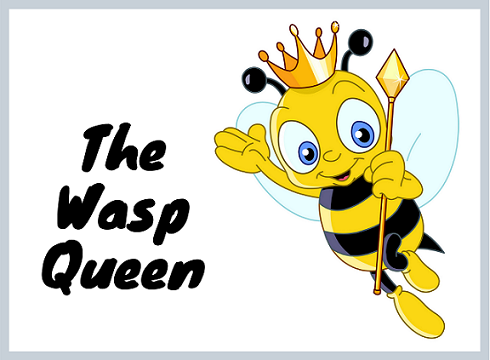IELTS Reading Practice – Sample 4

Answer these questions on the passage below.
Then, scroll down to the bottom of the page for the answers.
Choose
NO MORE THAN THREE WORDS AND/OR A NUMBER
from the text for each answer.
1) In which season does a queen wasp come out of
hibernation?
2) What substance does the queen wasp lick from the bodies of bees?
3) What is the average lifespan of a worker wasp?
4) What do wasps eat that makes them popular with farmers and gardeners?
5) What is a fertile male wasp called?
Reading passage:
The Wasp Queen
As the April sun rises
on a pile of firewood, something royal stirs inside. This wasp queen is one of
thousands who mated in late autumn and hibernated through the winter. Now she
emerges into the spring air to begin her reign. Most of her sisters weren’t so
lucky. While hibernating in compost piles and underground burrows, many
sleeping queens were eaten by spiders.
Warm winters caused by climate change led other queens to emerge early, only to find there was no available food. And some queens that survived the winter fell victim to the threats of spring, such as carnivorous plants, birds, and manmade pesticides. Our queen is the lone survivor of her old hive, and now, she must become the foundress of a new one.
But first, breakfast.The queen heads for a citrus grove full of honeybee hives. The bees can be dangerous if provoked, but right now they’re paralysed by the morning cold. Their hairy bodies are dripping with sugar water from an earlier feeding, and the resourceful queen licks them for a morning snack. Newly energised, our queen searches for a safe nesting area.
This tree hollow, safe from rain, wind, and predators, is ideal. She chews the surrounding wood and plant fibres to make a paper-like pulp. Then she builds around 50 brood cells that comprise the beginning of her nest. Using sperm stored from last fall, the queen lays a fertilized egg into each cell, producing as many as 12 in 20 minutes.
Within a week, these will hatch into female larva. But until then, the queen must hunt down smaller insects to feed her brood, all while expanding the hive, laying eggs, and defending against intruders. Fortunately, our queen is well prepared. Unlike bees, wasps can sting as many times as they need to. With such a busy schedule, the queen barely has time to feed herself. Luckily, she doesn’t have to. When she feeds an insect to her grubs, they digest the bug into a sugary substance that sustains their mother.
By the end of July, these first larvae have matured into adult workers, ready to take on foraging, building, and defence. The queen can now lay eggs full-time, sustaining herself on her worker’s spoils and their unfertilised eggs. Although each worker only lives for roughly 3 weeks, the queen’s continuous egg-laying swells their ranks. In just one summer, the nest reaches the size of a basketball, supporting thousands of workers.
Such a large population needs to eat, and the nearby garden provides a veritable buffet. As the swarm descends, alarmed humans try to swat them. They even fight back with pesticides that purposefully poison wasps, and inadvertently impact a wide range of local wildlife. But the wasps are actually vital to this ecosystem.
Sitting at the top of the local invertebrate food chain, these insects keep spiders, mites, and centipedes, in check. Wasps consume crop-eating insects, making them particularly helpful for farms and gardens. They even pollinate fruits and vegetables and help winemakers by biting into their grapes and jump-starting fermentation. This feast continues until autumn when the foundress changes course.
She begins grooming some eggs into a new generation of queens, while also laying unfertilized eggs that will mature into reproductive males called drones. This new crop of queens and males requires more food. But with summer over, the usual sources run dry, and the foraging wasps start taking more aggressive risks. By September, the hive’s organization deteriorates. Hungry workers no longer clean the nest and various scavengers move in.
Just when it seems the hive can no longer sustain itself, the fertile queens and their drones depart in a massive swarm. As the days grow colder, the workers starve, and our queen reaches the end of her lifespan. But above, a swarm of reproductive wasps has successfully mated. The males die off shortly after, but the newly fertilized queens are ready to find shelter for their long sleep. And this woodpile looks like the perfect place to spend the winter.
Source: TED-Ed Blog. Created by Kenny Coogan
Answers
Scroll down for the answers.


Answers:
1) spring
2) sugar water
3) roughly 3 weeks
4) crop-eating insects
5) (a) drone
To learn How to Answer Short Answer Questions, click this link.
Like this page?
More IELTS Reading Practice Samples
Here are a few examples of the many practice activites I've created:
Sample 1 – What matters most when speaking a new language
Sample 2 – Fire evacuation plan (GT)
Sample 3 – Climate change and loss of biodiversity
Sample 4 – The wasp queen
Sample 5 – Discovering our ancestors
Sample 6 – Telecommunication - undersea cables
Sample 7 – Biodiversity
Sample 8 – Mining asteroids
Sample 9 – Dress Code Policy (GT)
Sample 10 – How to fight desertification & drought
To see the full list of practice samples, click this link:
›



